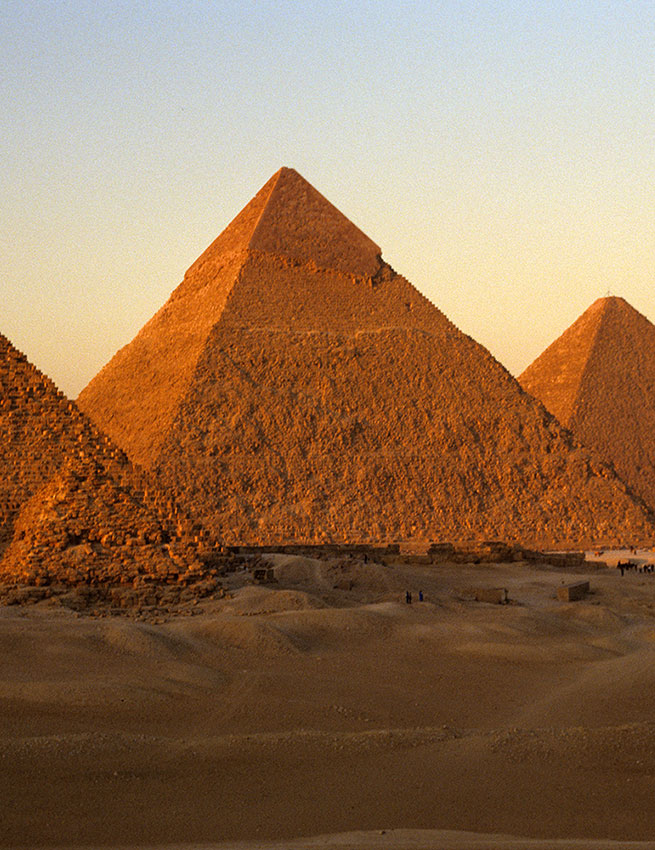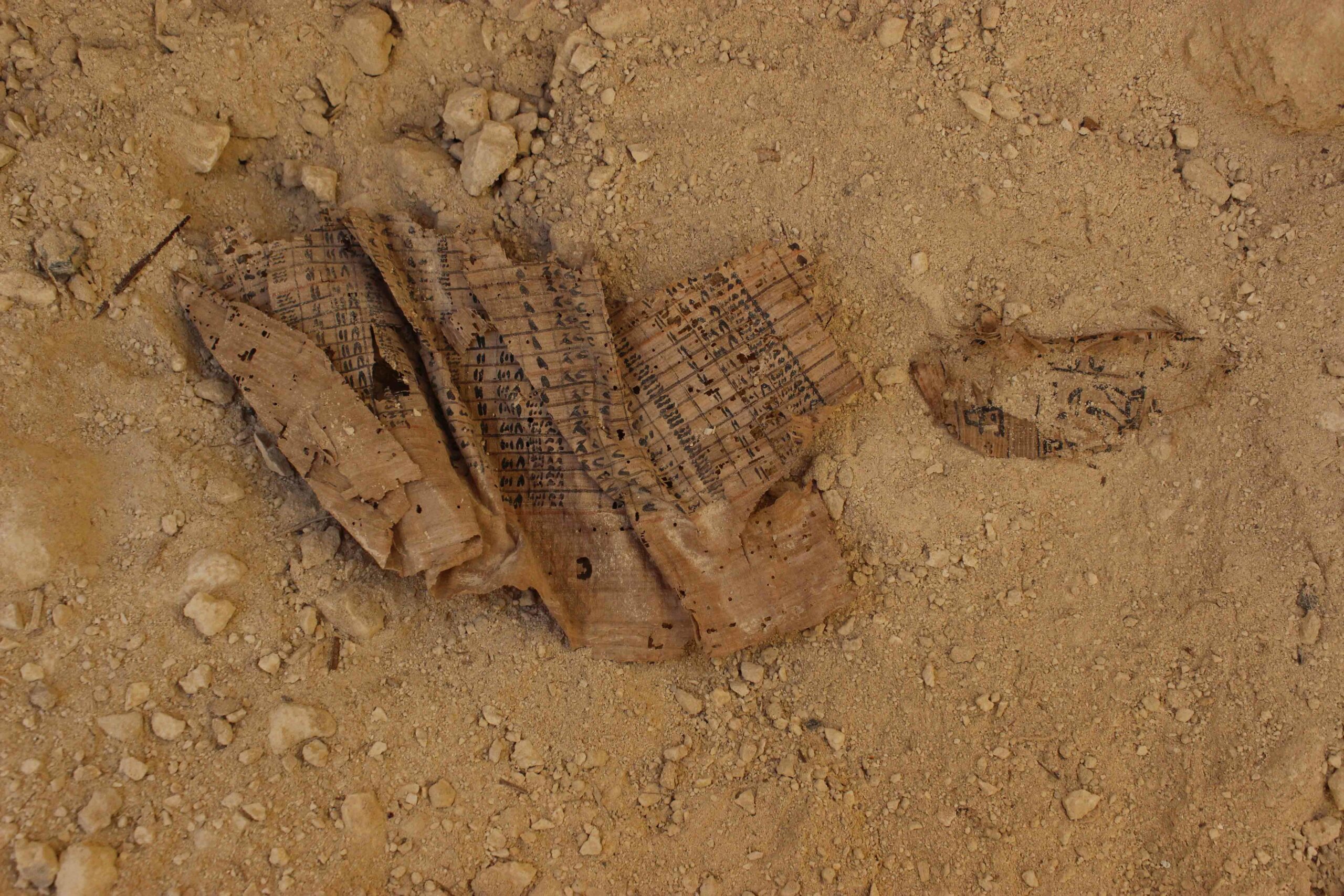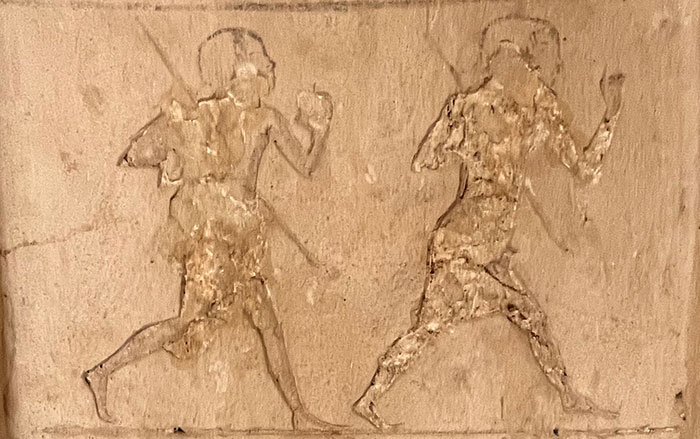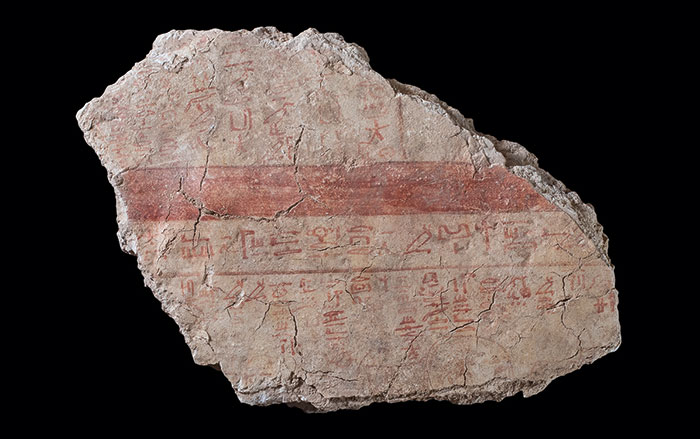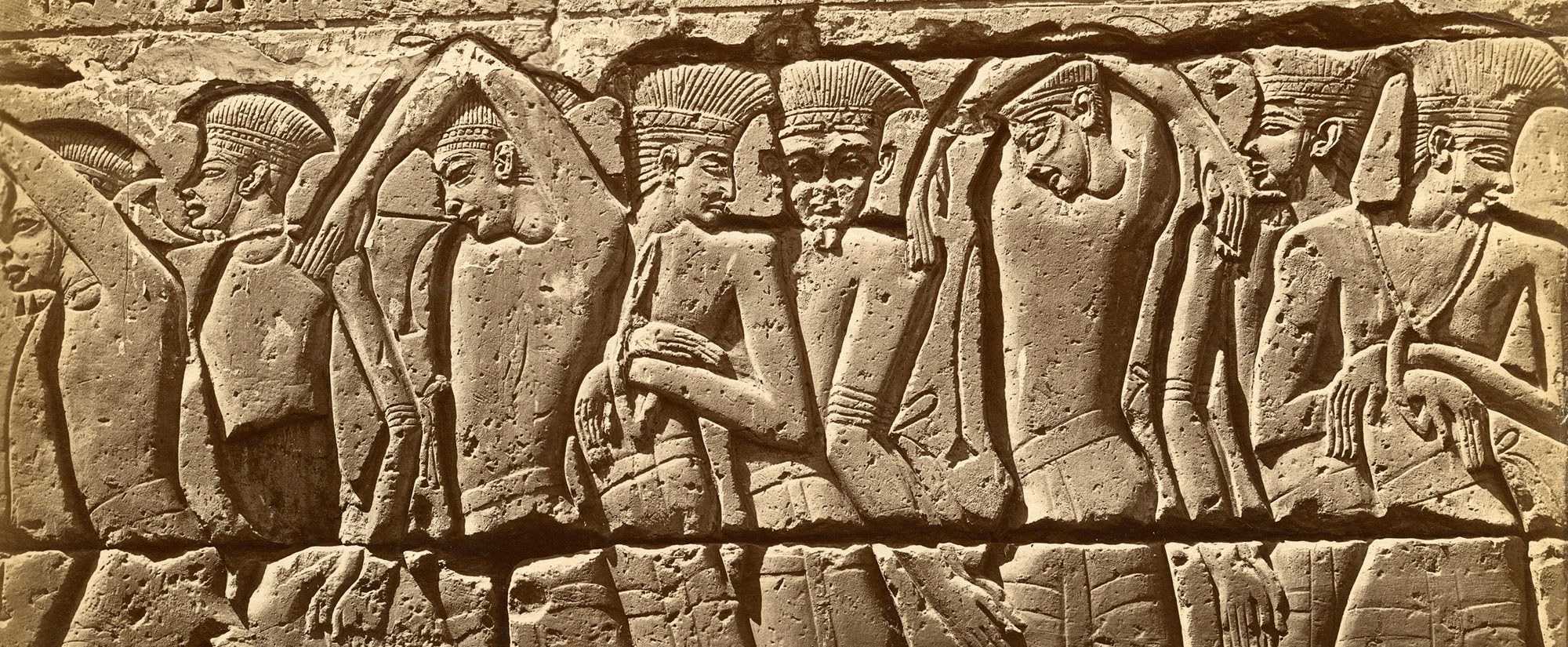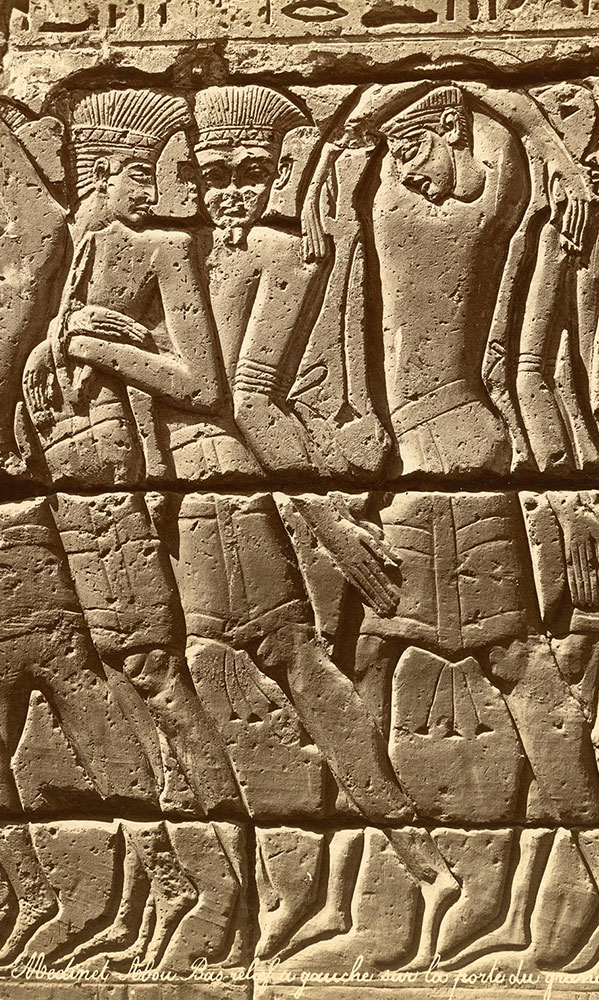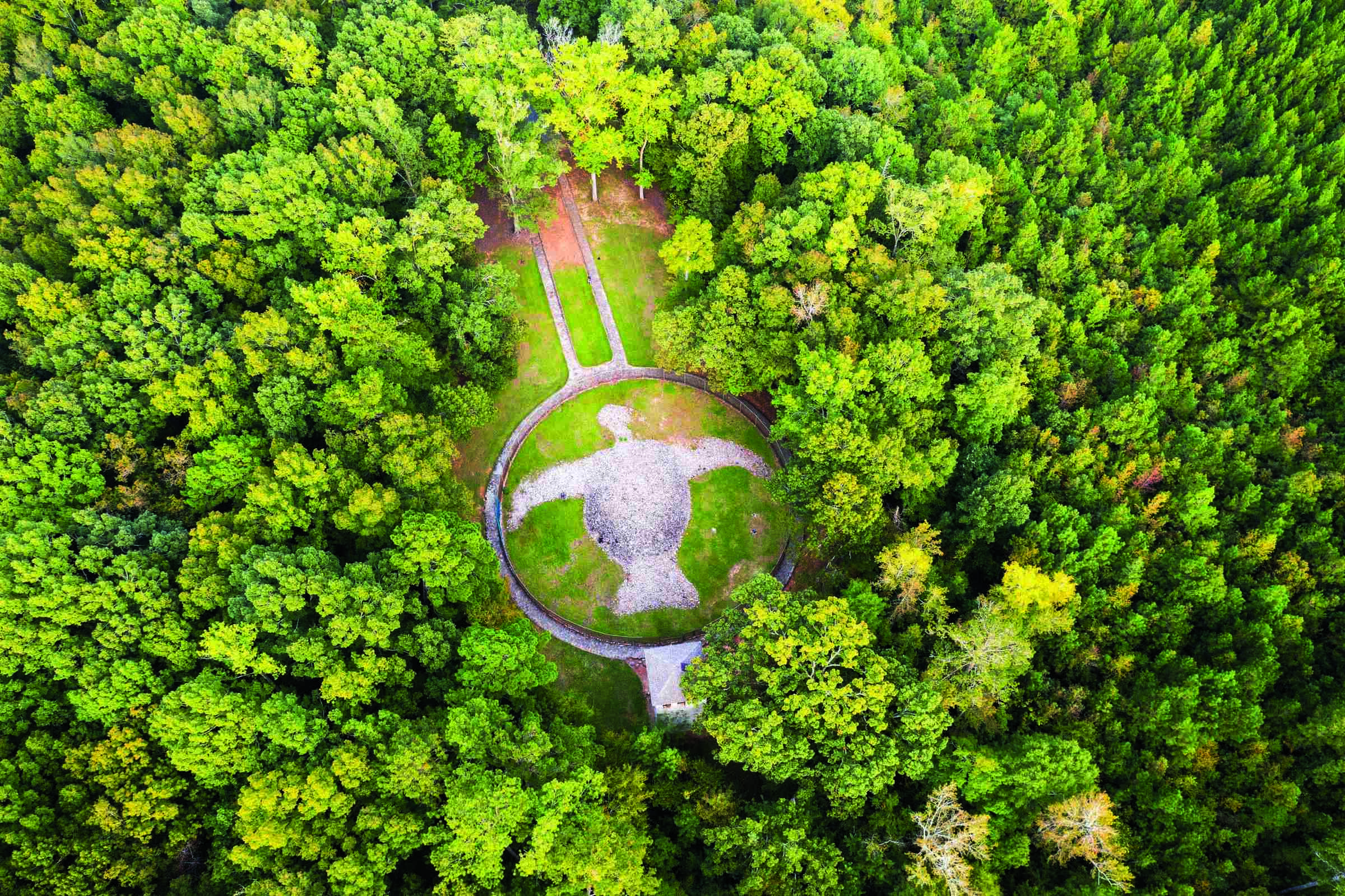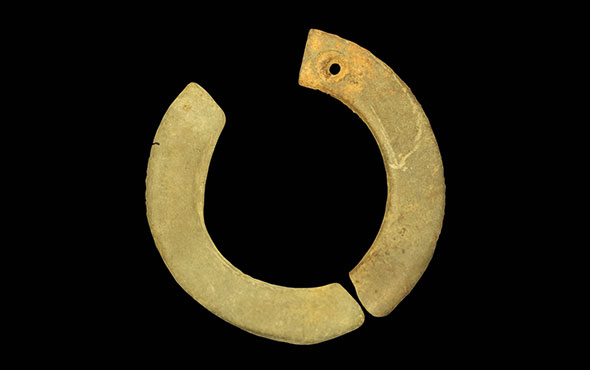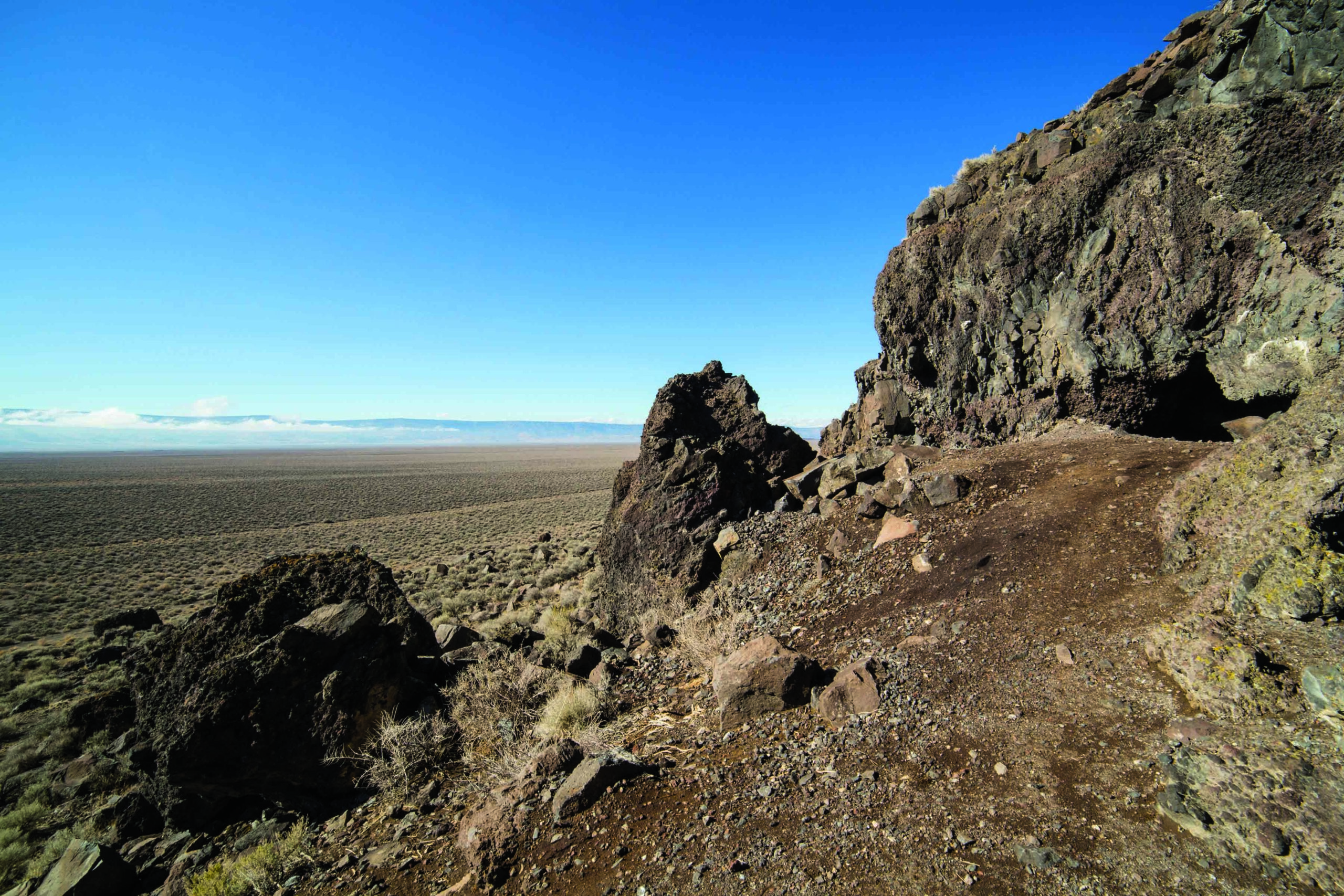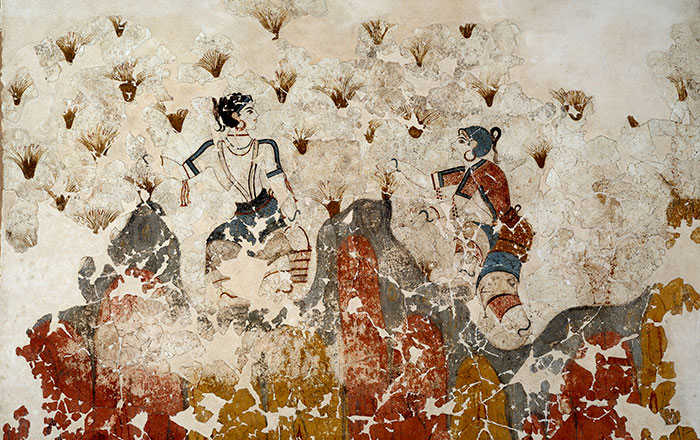
On a summer afternoon around 4,600 years ago, near the end of the reign of the pharaoh Khufu, a boat crewed by some 40 workers headed downstream on the Nile toward the Giza Plateau. The vessel, whose prow was emblazoned with a uraeus, the stylized image of an upright cobra worn by pharaohs as a head ornament, was laden with large limestone blocks being transported from the Tura quarries on the eastern side of the Nile. Under the direction of their overseer, known as Inspector Merer, the team steered the boat west toward the plateau, passing through a gateway between a pair of raised mounds called the Ro-She Khufu, the Entrance to the Lake of Khufu. This lake was part of a network of artificial waterways and canals that had been dredged to allow boats to bring supplies right up to the plateau’s edge.

As the boatmen approached their docking station, they could see Khufu’s Great Pyramid, called Akhet Khufu, or the Horizon of Khufu, soaring into the sky. At this point in Khufu’s reign (r. ca. 2633–2605 B.C.), the pyramid would have been essentially complete, encased in gleaming white limestone blocks of the sort the boat carried. At the edge of the water, perched on a massive limestone foundation, loomed Khufu’s valley temple, known as Ankhu Khufu, or Khufu Lives, which was connected to the pyramid by a half-mile-long causeway. When the pharaoh died, his body would be taken to the valley temple and then carried to the pyramid for burial. Nearby stood a royal palace, archives, granary, and workers’ barracks.

After offloading their cargo, the men anchored their boat in the lake alongside dozens—if not hundreds—of other boats and barges that had brought a variety of materials necessary to complete construction of the pyramid complex: granite beams from Aswan, gypsum and basalt from the Fayum, and timber from Lebanon. Also arriving by boat were workers from across Egypt and cattle from the Nile Delta to feed them. As the sun set and twilight deepened, hearth fires twinkled on land and on many of the boats. Merer and his men settled in for a night’s sleep, after which they would head back to the quarries to pick up another load of limestone blocks. They would make two or three such round trips in the next 10 days.
The Great Pyramid originally measured some 481 feet tall and 755 feet on a side. It was composed of an astounding 91 million cubic feet of stone—roughly the amount it would take to fill a football stadium to the top tier of seats. Although nowhere to be seen in the finished product, massive amounts of copper were essential to building the monument. Copper picks were used to quarry the stone. Copper saws were used to cut it, and experiments have shown that an inch of metal was lost from blades for every one to four inches of stone cut. While preparing the stone blocks for use in the pyramid, workers smoothed their surfaces with copper chisels the width of an index finger. The immense quantity of copper consumed by the construction project—not to mention the other pyramids and monumental buildings that preceded and followed it—led to an urgent search for sources of the metal.
EXPAND
Giza's Layout

In addition to providing unique insight into the experience of workers who helped build Khufu’s (r. ca. 2633–2605 B.C.) Great Pyramid, the papyri discovered at Wadi el-Jarf offer revealing clues to the layout of the Giza Plateau and its maritime infrastructure during the period of the pyramid’s construction. In the papyri, when Inspector Merer and his men are described approaching the plateau with a boatful of limestone blocks, they pass through the Ro-She Khufu (Mouth of the Lake of Khufu) into either the She Khufu (Lake of Khufu) or the She Akhet Khufu (Lake of the Horizon of Khufu). According to Egyptologist Mark Lehner, director of Ancient Egypt Research Associates, who has led excavations at the Giza Plateau for three decades, this supports scholars’ theory that the ancient Egyptians built a network of artificial basins that allowed heavily laden boats to deposit their cargo at the plateau’s edge, facilitating the delivery of materials necessary to construct the pyramid.
What appears to be the outline of one of these basins— likely the She Akhet Khufu—was detected through test excavations carried out in the late 1980s and early 1990s. The basin’s western edge seems to have been the site of Khufu’s valley temple, which had a massive limestone foundation covered with black basalt slabs. Sections of colossal walls forming the other three sides of the basin, also composed of basalt on limestone foundations, have been located as well. In all, the basin measured around a quarter of a mile by a third of a mile. Based on cores taken from its center, Lehner believes the basin was dredged to a depth of between 26 and 33 feet, allowing ample clearance for boats such as that captained by Inspector Merer. “The correspondence between archaeology and the texts from Wadi el-Jarf is phenomenal,” says Lehner.
Some copper was extracted from the Eastern Desert, between the Nile Valley and the Red Sea, but the major copper mines were across the sea in the southern portion of the Sinai Peninsula. The most efficient way to access these mines was by boat. Until just over a decade ago, the earliest known Red Sea harbor was at Ayn Sukhna, which was excavated starting in 2001 by a team led by Egyptologist Pierre Tallet of the University of Paris-Sorbonne. The harbor at Ayn Sukhna appears to have been used intermittently for more than a millennium to access the Sinai, starting during the reign of Khafre (r. ca. 2597–2573 B.C.), Khufu’s son. Then, in 2008, Tallet’s team relocated a previously known but little understood coastal site at Wadi el-Jarf, some 60 miles south of Ayn Sukhna, and found that it had served as a harbor for around 50 to 70 years in the 4th Dynasty (ca. 2675–2545 B.C.), including the reign of Khufu. It is the earliest known harbor in the world.
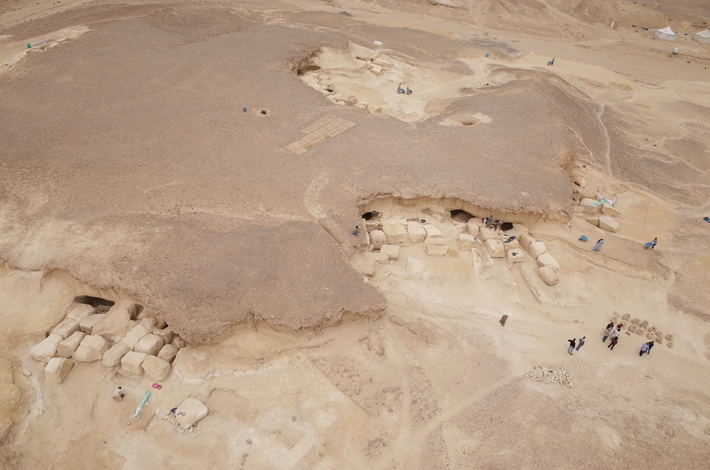
In ongoing excavations that began in 2011, a joint expedition from the University of Paris-Sorbonne, the French Institute of Archaeology in Cairo, and Assiut University has discovered that the harbor at Wadi el-Jarf was a sprawling enterprise where hundreds of workers supported mining operations in the Sinai. The team has uncovered evidence of how these laborers were organized into groups to ensure that the site functioned smoothly. And, in a wholly unexpected and unprecedented find, they have unearthed a cache of inscribed papyri containing records of the day-to-day activities of one such group of workers—the boatmen overseen by Inspector Merer. In addition to transporting stone blocks used to build the Great Pyramid complex on the Giza Plateau, these men took part in operations elsewhere in the country, including helping to run the harbor at Wadi el-Jarf.
By studying these papyri and examining their findings at Wadi el-Jarf and on the Sinai Peninsula, Tallet and his colleagues have gained new insight into the state apparatus and the workforce that helped produce some of the world’s most awe-inspiring monuments. “It seems that at the beginning of the Fourth Dynasty, the Egyptians were trying to do everything big,” says Tallet. “Everything they were doing at the time is oversized. It’s the case at the Giza Plateau with the pyramids, and it’s the case at Wadi el-Jarf as well.”
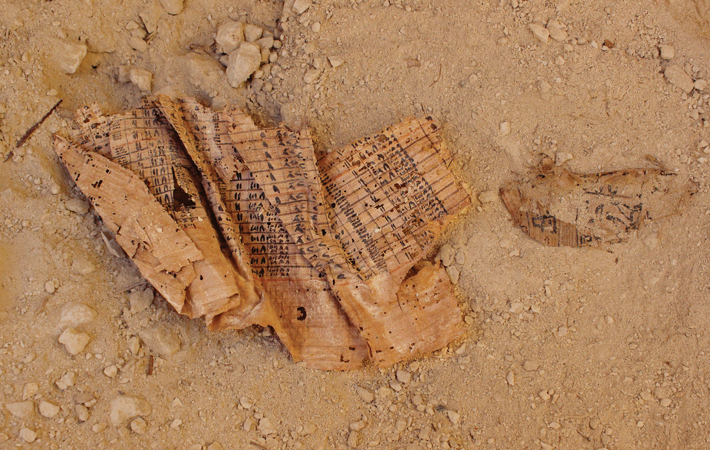
For Tallet, the first clue that Wadi el-Jarf had been a port was the presence of storage galleries carved into limestone foothills some three miles from the coastline. He had found similar galleries at Ayn Sukhna, which were used to safeguard boats and other materials when the port was not in use. As the team began investigating Wadi el-Jarf, additional evidence quickly emerged. A natural opening in the reefs offshore would have allowed for easy passage of boats, while an L-shaped jetty, each leg of which measures around 650 feet long, created a 12-acre zone of calm water directly in front of this opening. Near the shore, the archaeologists excavated a pair of structures that appear to have been used for lodging, food production, and processing goods. Between the structures, they found more than 100 stone anchors, some with ropes still attached. Around a mile and a half inland they unearthed a building divided into 13 parallel rooms that measures some 200 feet by 130 feet, making it the largest known ancient building on the Red Sea coast. Researchers believe it likely housed around 500 workers.
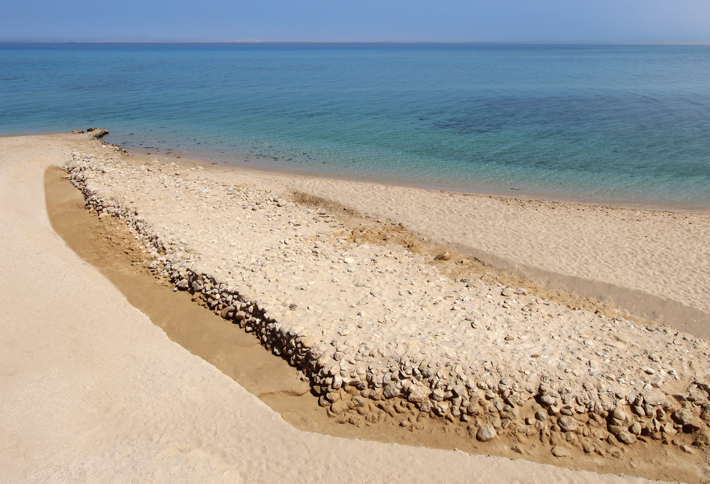
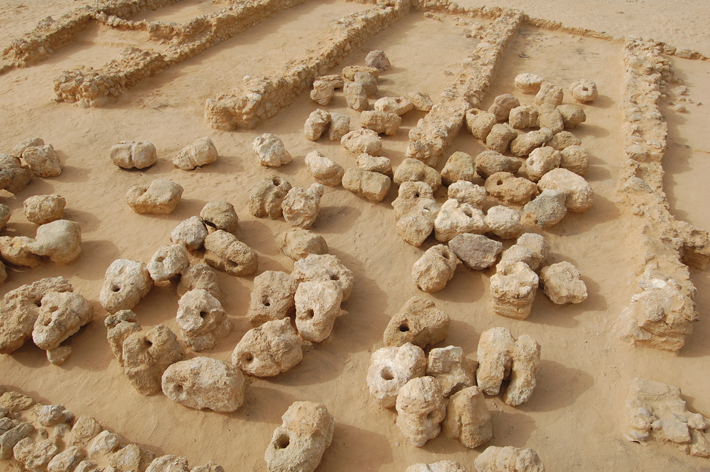
When the team first arrived at the site, they found that the entrances to the 31 storage galleries had been sealed with large limestone blocks. Inside almost all the galleries they have explored, which range in length from 50 to 100 feet, the archaeologists have uncovered large quantities of cedar, pine, and rope fragments, indicating that, as at Ayn Sukhna, the galleries were used to store boats during those parts of the year when dangerous weather conditions made the Red Sea unnavigable. Many of the galleries were also filled with ceramic storage jars, which have been key to helping Tallet’s team understand how the port worked. Given that the closest source of fresh water is a spring around six miles inland from the galleries, the researchers believe the eight-gallon jars were used to store water for harbor workers, as well as to transport goods to and from the Sinai. A number of broken jars have been found in the water near the shore. Still more have been discovered at a fortress known as el-Markha some 30 miles across the Red Sea from Wadi el-Jarf, evidence that it was the destination for expeditions from the harbor and likely served as a base for Sinai mining operations.
Pinpointing which Sinai copper mining and processing sites were being used in Khufu’s time can be difficult, but a complex of furnaces discovered in 2009 by Tallet at Seh Nasb, 10 miles north of el-Markha, gives a sense of the enterprise’s gargantuan scale. The furnaces—at least 3,000 in total—were used in an early stage of processing copper ore and were arranged in large batteries that spread out over more than half a mile. “The size of the installation makes me think this was probably from the Fourth Dynasty, when the Egyptians had a very dramatic need for copper,” says Tallet. “It’s absolutely huge.”
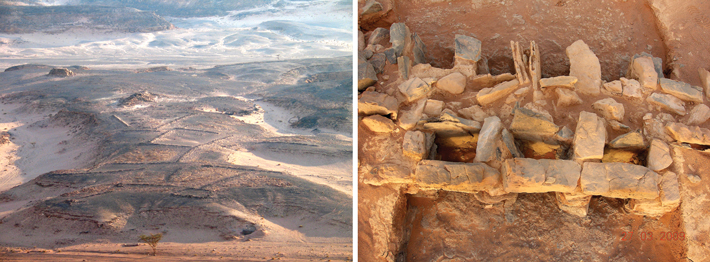
The harbor at Wadi el-Jarf must have been a hive of carefully coordinated activity. Boats would have been carried around 100 miles across the desert from the Nile Valley in parts and assembled at the site. Mine workers, along with others delivering food and supplies such as wood to fuel the copper-processing furnaces, would also have made the trek. Trains of donkeys would have constantly filed back and forth from the harbor to fetch water from the inland spring. And boats would have shuttled to and fro across the Red Sea, sending workers and supplies and returning with copper. Overlooking the site was a pair of hilltop camps situated above the storage galleries. These camps have yet to be excavated, but the researchers believe they were a control point where overseers monitored the harbor and could observe anyone approaching on desert trails. “Managing the site was an incredible logistical operation,” says Gregory Marouard, an archaeologist at Yale University who is part of Tallet’s team. “It took at least seven days to cross the desert from the Nile Valley, and they had to bring everything with them. There were also probably several different groups of workers involved, doing different jobs. And it was a seasonal operation, so when they organized a new expedition, people had to come to reopen the galleries, rebuild the boats, and so on.”

Even before researchers uncovered the papyri detailing the activities of Merer and his men, many texts had already been found at Wadi el-Jarf. The ceramic storage jars, the large limestone blocks used to seal the storage galleries, and even the assemblage of stone anchors are all covered in hieroglyphs. The first thing the researchers noticed about these texts was the frequent presence of Khufu’s cartouche, an oval containing the pharaoh’s name, which helped establish that the site was used during his reign. As they looked further, they concluded that the texts consist of the names of work gangs that operated the harbor, such as “The Escort Team of ‘Great Is His Lion’” and “The Escort Team of ‘Khufu Confers on It His Two Uraei.’” “It took some time to understand what these names meant,” says Tallet. “But in the end, we figured out that these teams were probably named after the boats to which they were linked. And each boat was named from a royal insignia that it bore.” Thus, Inspector Merer’s “Escort Team of ‘The Uraeus of Khufu Is Its Prow,’” which was found written on hundreds of storage jars, apparently crewed a boat whose prow was decorated with the snake ornament worn by the king. The researchers would soon learn much more about these particular laborers.

In the first few years of their excavations at Wadi el-Jarf, Tallet’s team unearthed a number of small blank or faded pieces of papyri, tantalizing hints that the site might hold inked papyri that had been waiting more than four and a half millennia to be found. In 2013, the researchers’ hopes were realized to a degree far greater than they could have imagined. While investigating the area in front of two storage galleries, they uncovered a few bits of papyri with red and black ink that proved to be scraps of accounting documents. Just under a week later, they excavated the first complete papyrus, which included one of Khufu’s royal names, Medjedu, or “the one who crushes.” This established it as the oldest inscribed papyrus ever found.
As the end of the dig season neared, one area remained to be explored: the space between two of the limestone blocks in front of one of the galleries. There, the team found hundreds of fragments belonging to several dozen different texts, including some that could be pieced together into documents measuring nearly two feet long. They soon recognized that, in addition to accounting documents, they had discovered logbooks kept by Inspector Merer. These papyri detail the activities of a group of some 40 men, known as a phyle, who were one of four such units that made up “The Escort Team of ‘The Uraeus of Khufu Is Its Prow.’” The discovery was highly serendipitous. Such records would normally have been brought back to the Nile Valley to be archived, but, for some reason, these documents were left at Wadi el-Jarf. The surviving papyri seem to have been originally buried in a pit between the limestone blocks and subsequently moved, most likely as part of an attempt to open the gallery. Those papyri that remained in the pit had largely decomposed after sitting in stagnant water, while those that were disturbed were saved for posterity. “This kind of narrative is very rare from the time,” says Tallet. “All the narrative texts we have from the Fourth Dynasty are basically biographical texts found in tombs. For the first time, we had something that was by a real person giving a precise and real account of their work.”

The logbooks cover the phyle’s activities for just over a year near the very end of Khufu’s tenure. In the summer months, roughly June to November, the workers operated in the vicinity of Giza. The beginning of this period was the first month of the inundation season, called Akhet, corresponding to the arrival of the annual Nile flood. The phyle’s first assignment appears to have involved transporting around 600 workers to the Ro-She Khufu. There, Tallet believes, based on references in the logbooks to “works related to the dike of Ro-She Khufu,” “the dam of the entrance of Khufu’s lake,” and the team “lifting the piles of the dike,” these workers opened the floodgates to fill the basins and canals that allowed goods to be delivered to the foot of the pyramid complex construction site. (See “Giza’s Layout.”)
With these waterways open, Merer’s men then spent several months hauling loads of fine limestone blocks from the Tura quarries to the Giza Plateau. A typical set of entries reads “Inspector Merer casts off with his phyle from Tura, loaded with stone, for Akhet Khufu; spends the night at She Khufu…. Sets sail from She Khufu, sails toward Akhet Khufu, loaded with stone; spends the night at Akhet Khufu.” The team picked the blocks up from two separate quarries—Tura North and Tura South—alternating every 10 days so quarry workers had time to extract stone and pile up blocks in anticipation of their next visit. These blocks were the sort used to encase the Great Pyramid, but this late in Khufu’s reign, it’s believed that this work would already have been completed. According to Egyptologist Mark Lehner, director of Ancient Egypt Research Associates, the blocks were most likely used as roofing for one of the pits near the pyramid that held cedar boats that would be used in Khufu’s funeral. “If it’s that close to the end of Khufu’s reign, maybe they were delivering the Tura limestone blocks for covering those boat pits, which are where they buried the funerary hearse boats,” he says. “I think that’s what makes the most sense.”
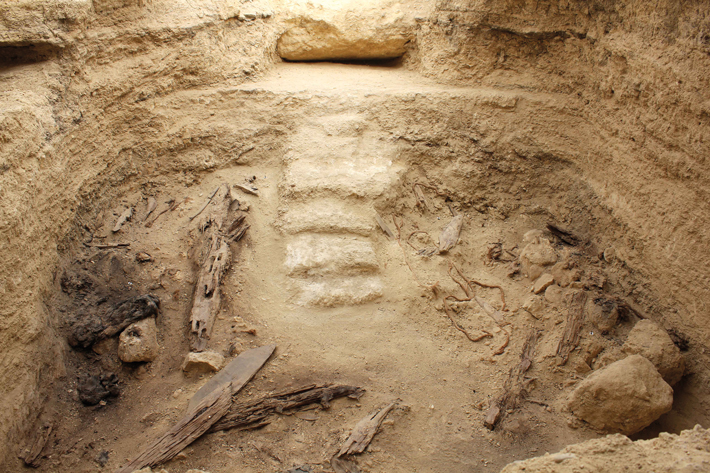
In December, when the Nile flood had ebbed and transporting heavy loads by boat to the Giza Plateau was no longer feasible, Merer’s phyle was sent to an area of the Nile Delta near a pair of towns. The names of these towns—Ro-Wer Idehu, or the Great River Mouth in the Marshes, and Ro-Maa, or the True River Mouth—likely refer to points where one or more of the Nile’s branches opened into the Mediterranean. There, the team was tasked with “tamping” or “compacting” a structure called a “double djadja,” which Tallet believes was likely a jetty of the sort uncovered at Wadi el-Jarf. Such a structure would have supported maritime expeditions to the Levant to obtain, among other materials, pine and cedar, which were generally unavailable in Egypt but were essential for making boats and stoking the fires used to process copper ore. “At that time in history, the Egyptians were trying to connect as much as they could with the outer world,” says Tallet. Ensuring the team did not go hungry or thirsty during this remote posting, the papyri note that an official named Imery made several trips to fetch rations of bread and beer.

The papyri include no mention of the phyle’s activities from January through March, and Tallet believes this may have been a season when the workers could return home to spend time with their families. Starting in April, the phyle appears to have been working at Wadi el-Jarf. While the logbooks covering this period are quite fragmentary, they do mention sailing expeditions, as well as a place called Ineb Khufu, or Walls of Khufu, which may refer to the el-Markha fortress. Given that the phyle came to Wadi el-Jarf at the beginning of the Red Sea sailing season, which continued through the end of the summer, they were likely tasked with getting the harbor up and working again. This would have involved moving or smashing the limestone blocks that sealed the galleries, reassembling boats, and making sure they were seaworthy. Only then could they launch their boat with its uraeus prow to ferry miners, goods, and copper back and forth between the harbor and the Sinai.
Based on the contents of the papyri, Tallet believes that at least some workers in the time of Khufu were highly skilled and well rewarded for their labor, contradicting the popular notion that the Great Pyramid was built by masses of oppressed slaves. In several instances, Merer and his team were awarded gifts of textiles. In addition to a diet including poultry, fish, fruit, and a variety of breads, cakes, and beers, the men were also provided with dates and honey, delicacies that were extremely scarce and generally reserved for those within the royal entourage. In fact, the laborers may have been quite close to the royal family. During their several months working at the Giza Plateau, Inspector Merer’s phyle—and possibly other phyles that were part of the same group—appears to have taken turns guarding and helping to provision a royal institution called Ankhu Khufu, which likely referred to Khufu’s valley temple. In the papyri, Merer’s men are called the setep za, “the chosen phyle” or “the elite,” a phrase that can denote a royal guard force. “I think these boatmen were a very special category of workers because their activities were really vital for the royal project,” says Tallet. “I think the monarchy had an interest in being fair to them because it was essential to have them working well.”
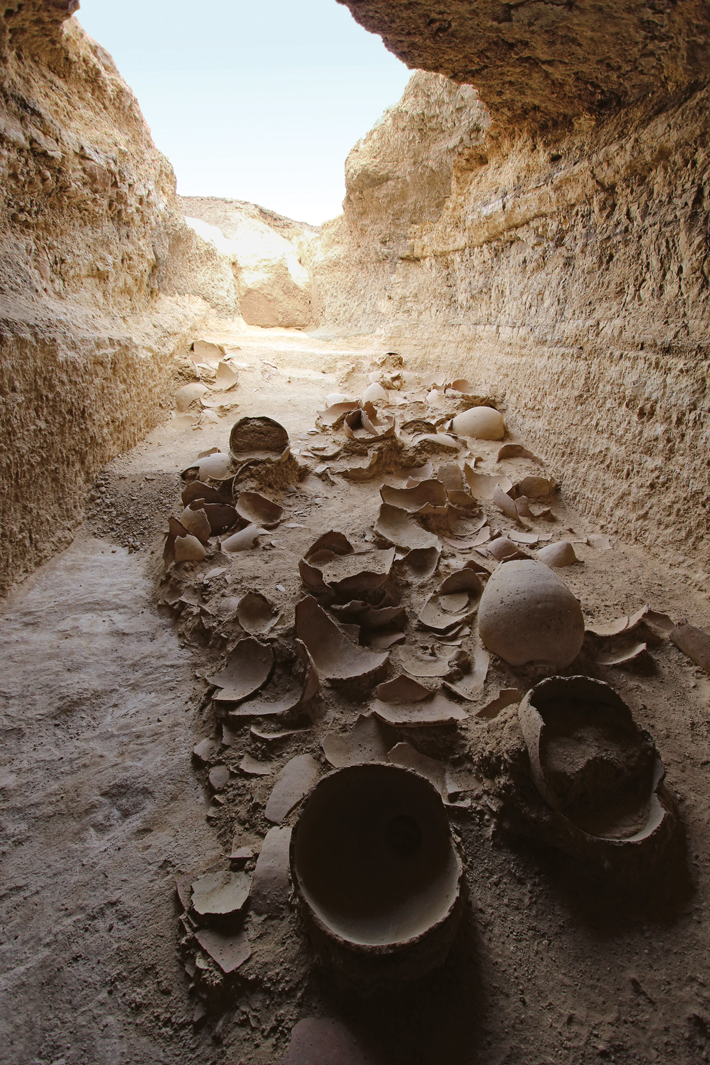
It’s difficult to say whether workers such as those who quarried stone for use in the pyramid and those who lifted the stones and placed them on the structure itself received similarly favorable treatment. There are, however, some indications that they also had access to coveted resources. For the past 30 years, Lehner has been excavating at a site called Heit el-Ghurab on the Giza Plateau, where, starting just a decade after Khufu’s death, workers who built the pyramids of the pharaohs Khafre (r. ca. 2597–2573 B.C.) and Menkaure (r. ca. 2572–2551 B.C.) are believed to have lived in barracks. Lehner’s team has uncovered evidence of dozens of bakeries that surrounded the barracks complex along with a quantity of animal bones suggesting that several thousand workers living there ate meat every day. “That is not usually the case in the ancient Middle East,” Lehner says. “It looks like people were being fed a lot of protein and carbohydrates.”
Deeper layers at Heit el-Ghurab that have yet to be explored likely date to Khufu’s time and may reveal more about the workers who built the Great Pyramid. For now, though, the Wadi el-Jarf papyri offer an unparalleled view of the pyramid complex as it was being built and of the experience of the workers who helped build it. “I’ve often thought it would be great to be back there for fifteen minutes to see what was happening,” says Lehner. “The Wadi el-Jarf papyri are the closest thing we have to that.” The portrait these documents convey is of resourceful workers who roamed from the country’s sacred core to some of its most remote precincts gathering the materials to create enduring monuments that furthered their leader’s ambitions and stand as a testament to their skill and dedication.



